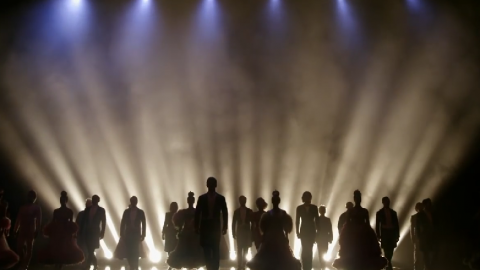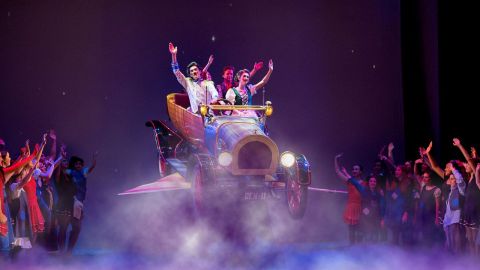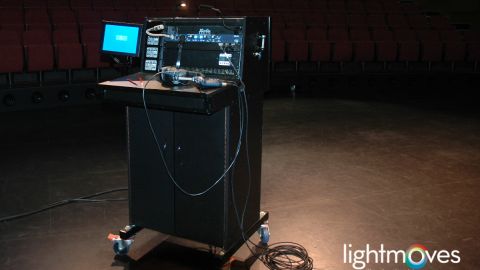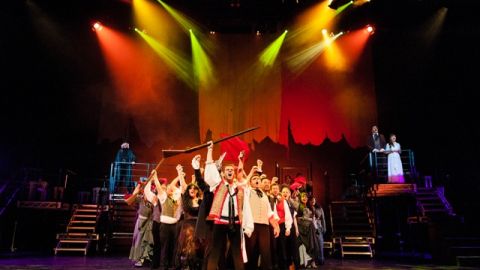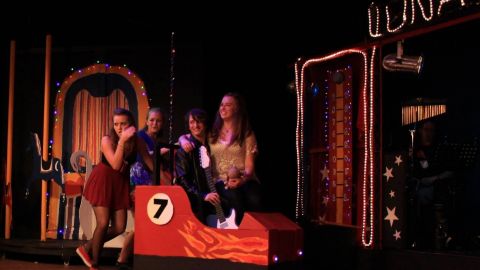Director’s Diary: The Who’s Tommy
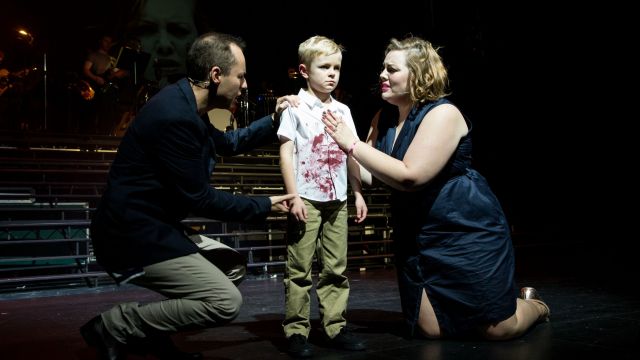
Jessica Lovelace directed Tommy for the Blue Mountains Musical Society inside the mega Leagues Club Panthers in western Sydney. She merged the best of music theatre with rock concert pizazz and stunning audio visuals to please any Pinball Wizard.
When my husband and partner in music theatre crime and I looked around the EVAN Theatre, we knew a rock show suited this quintessential touring cover band venue.
We wanted to project close-ups of the performers on massive screens, incorporate live tweeting, and light the place up like a Christmas tree. The show to do that with was The Who’s Tommy. The poor reception meant tweet seats were not worth the hassle, but aside from that technicality, the Tommy we imagined opened at Panthers.
I didn’t think twice about directing Tommy. I loved the music, the surreal plot, and the inherent aesthetic beauty in the writing. I’d listened to the music once and the visuals had just fallen into place; it’s music that needs to be on a stage. But I soon found out it’s a show people are afraid of.
I would talk to potential cast members and they would say, “I read the Wikipedia page and it sounds a bit… you know…” As someone who came from the theatre world, I had forgotten the music theatre’s penchant for Disney and petticoats. Of course you can be ‘edgy’ and do RENT or Spring Awakening (both based on texts that were controversial over a century ago), but performing a musical that deals with common issues that are experienced by families everywhere, is suddenly off-limits. I realised quickly it was a hard show to get people excited about, from potential cast members to potential audiences. You see, Tommy features a 90 second song called ‘Fiddle About’ between a 10 year old Tommy and his uncle. Spoiler alert: it’s not about the uncle’s love of violins.

Central to the somewhat convoluted plot of Tommy is a mirror. It is the mirror through which Tommy witnesses the murder of his mother’s lover, and the main physical representation of his trauma. In order to reflect (pun very much intended) the themes of the show, our ‘mirror’ would be the screen. What better way to represent the YouTube generation?
His mother and lover would leave the camera recording during their love-making session, but then his father would walk in. The camera would then catch the ensuing fight and murder, and Tommy would see this projected on the stage-sized screen. After many different attempts at curing Tommy, his mother then discovers the answer lies in smashing the mirror he has been bound to for so many years. In our production, she simply pulls the plug on the camera and the screen goes black for the first time.
The decision to make ‘Smash The Mirror’ the first moment of blank screen meant we had forced ourselves into having wall-to-wall AV content either side of it. The decision to introduce the onstage camera in ‘Twenty-One’ meant we had to have content other than live feed for the first few scenes which are packed full of exposition. And we were on a community theatre budget.

My husband Matt set out to teach himself how to make click tracks, and I set out to teach myself how to use Final Cut Pro beyond cross-fades.
With the help of our Technical Manager, Aubtin Namdar, we filmed the cast for eight hours one weekend. I edited this footage to sync up with the onstage action and at particular points, to intentionally NOT sync up (such as when Tommy is losing his sight and hearing).
I trawled YouTube for found footage that could be used to provide context for the story during the establishing scenes. I created social media accounts for all the lead characters and online newspaper pages so I could screenshot them and use them to flesh out the story of Tommy as a ‘Sensation’.
I enlisted the help of a graphic designer friend, Brad Roddy, to create the view of the pinball screens we would see when Tommy was playing Pinball on his smart phone, and other more graphic elements of the AV.

We set up three GoPros on the band (Drums, Keys, and Guitar), to highlight and star the band. And our poor camera operator, Adrian Hastings, had to come in at the very last minute and choreograph himself into the show to catch all of the moments that needed to be live.
We also made the decision to pre-record some dialogue and singing (particularly of the children because we didn’t know if we would be able to cast 4 Year Old and 10 Year Old Tommys who were both cute AND could hold a tune, and to play on the motif of the senses that is so clearly running through the show.
These tracks had to be manually triggered at times, and set to click track at other times. In hindsight, I have no idea what I was taking that made me think we’d be able to pull any of this off. But we did.
When I was studying theatre, we could spend up to four hours teching for each half hour of show time. Every cue was precise and everyone knew what they needed to do during any minute of the show. But when you arrive at a venue on a Sunday, your closing night is the following Sunday and everyone involved works 9 to 5, the reality is often is a 2.5 hour tech rehearsal for a 2.5 hour show.

And the director or stage manager meets the sound engineer and lighting operator for the first or second time on that Sunday. With all of the technical elements in Tommy, certainly more than I had experienced in a community show before, we were incredibly apprehensive going into production week. We were able to secure two three-hour technical rehearsals, so that we could spend a night on each act, which is a great luxury.
With a great deal of preparation, and the right people to work with, it can be done. When the cast have been drilled to work as a unit, to know their entrances and exits and their costume changes back to front, you’ve eliminated one technical element. Any special effects have already been drilled and handed over to the stage crew to manage. You have all of your paperwork prepared before production week – you’ve passed the mic plot and sound effects plot onto the sound engineer, you’ve got marked up scripts and cue sheets ready to go. If you, as a community theatre production team, have done every single piece of preparation that can be done, then you are creating an environment in which the contractors (whether their payment is insignificant or half your budget) can provide you with their best work. Like so many things in the theatre, in order to get that beautiful sense of improvisation and immediacy the audience craves, a huge amount of preparation is required.
Too often I see the comment that the ‘professionals’ are the ones letting the show down, but I seldom see this being an accurate reflection of the process. They’re coming in at the last minute. You have to hand them the show you have put your blood, sweat and tears into for months in a way that is clear, and achievable. We suffered two technical issues in the run. The first, we still don’t know what happened. A pre-recorded interview that the onstage Tommy was to lipsync to played, but without sound. We checked everything, and I don’t think we’ll ever know what went wrong that day.
And the second was closing night. The show had started and there was nothing on the screen. No one had turned the projector on. And that’s just one of those things you have to laugh about. It was turned on 30 seconds into the show at an appropriate time and no audience member would be any wiser. Except for the director in the back row with steam coming out of her ears.
Origially published in the September / October edition of Stage Whispers.

